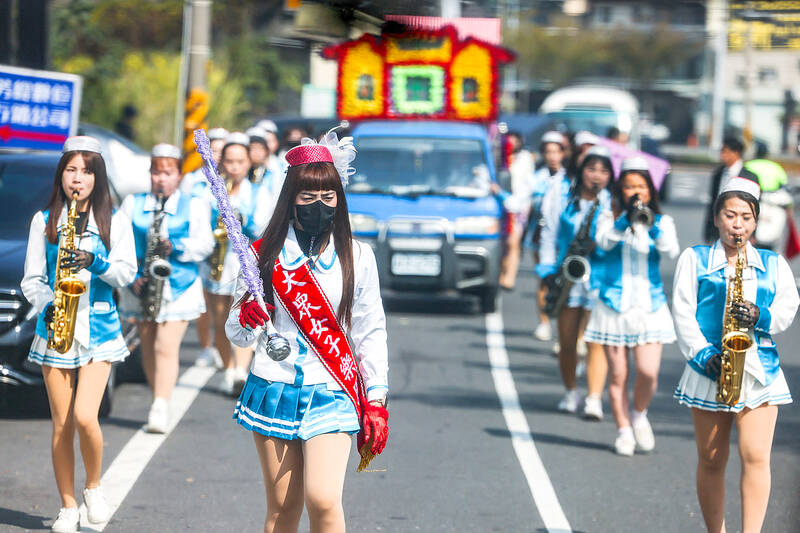At a funeral in rural Changhua County, musicians wearing pleated mini-skirts and go-go boots march around a coffin to the beat of the 1980s hit I Hate Myself for Loving You. The performance in a rural farming community is a modern mash-up of ancient Chinese funeral rites and folk traditions, with saxophones, rock music and daring outfits.
Da Zhong (大眾) women’s group is part of a long tradition of funeral marching bands performing in mostly rural areas of Taiwan for families wanting to give their loved ones an upbeat send-off. The band was composed mainly of men when it started 50 years ago and has evolved into an all-women ensemble.
“I constantly try to innovate, come up with new ideas, and adapt to modern times,” said band manager Hsu Ya-tzu, 46, whose mother-in-law founded the group. “I want to break away from rigid traditional mindsets to keep this profession relevant.”

Photo: AFP
Starting before dawn, the women marched in formation playing their saxophones and a drum as the leader twirled her baton and blew a whistle.
The music was loud enough to wake the nearby living as they led the coffin and mourners to a cemetery or crematorium where traditional funeral rites were performed.
“It felt like a celebration, almost like a joyous occasion rather than a funeral,” said mourner Hsiao Lin Hui-hsiang, 74, as his family cremated an elderly relative.
“Since she lived past 90, it was considered a happy farewell.”
Funeral director Chang Chen-tsai said marching band performances were supposed to “liven up the atmosphere” of funerals and were usually reserved for the old.
“It should be lively, it cannot be too quiet,” said Chang, 64, who has been organizing funerals for 40 years.
LIPSTICK, WHITE BOOTS
It was still dark out when Hsu pulled up in her van at a meeting point to collect other band members for an early morning gig. The women aged from 22 to 46 applied lipstick and pulled on white boots before grabbing their instruments and walking to the covered courtyard venue where mourners gathered near the coffin.
Hsu’s mother-in-law, Hung Sa-hua, recalls being one of the only women in the funeral marching band profession when she started her own group in 1975.
As the male performers got old and retired, she replaced them with women, which customers preferred, the 72-year-old said.
For Hung, the band was an opportunity to make some extra money after she married her husband and to get out of the family home.
“If I never went out and always stayed at home, I wouldn’t have known what was happening in society,” Hung said.
‘CONSTANTLY INNOVATING’
Taiwan’s funeral marching bands are rooted in Chinese and folk rituals, and during the last century began using Western instruments, said Wu Ho-yu, 56, a high school music teacher who has studied the tradition.
“Since people appreciate its entertainment aspect, bands continue following this style, constantly innovating to offer something even better,” Wu said.
Hsu said the band had changed with the times. Many years ago, for example, the women wore trousers but now super-short skirts were acceptable. Finding new performers was a challenge due to the early morning starts, said Hsu, who has expanded into birthday parties, company year-end events and grand openings.
“Nowadays, fewer and fewer people are willing to enter this industry,” she said. “We are all getting older, but this job needs young people to carry it forward, it requires energy, and only with energy can it truly shine.”
Hsu said she introduced rock songs — such as I Hate Myself for Loving You by US band Joan Jett and the Blackhearts and Leaving the Face of the Earth (Jump!) by Taiwanese group Mayday — into their repertoire to give their act a more contemporary sound.
Some elderly mourners initially objected, but younger ones embraced it.
“As long as it’s a song the deceased wanted to hear, anything is okay,” Hsu said.
“The old traditions, where certain songs were considered taboo, no longer apply.”

The Nuremberg trials have inspired filmmakers before, from Stanley Kramer’s 1961 drama to the 2000 television miniseries with Alec Baldwin and Brian Cox. But for the latest take, Nuremberg, writer-director James Vanderbilt focuses on a lesser-known figure: The US Army psychiatrist Douglas Kelley, who after the war was assigned to supervise and evaluate captured Nazi leaders to ensure they were fit for trial (and also keep them alive). But his is a name that had been largely forgotten: He wasn’t even a character in the miniseries. Kelley, portrayed in the film by Rami Malek, was an ambitious sort who saw in

Last week gave us the droll little comedy of People’s Republic of China’s (PRC) consul general in Osaka posting a threat on X in response to Japanese Prime Minister Sanae Takaichi saying to the Diet that a Chinese attack on Taiwan may be an “existential threat” to Japan. That would allow Japanese Self Defence Forces to respond militarily. The PRC representative then said that if a “filthy neck sticks itself in uninvited, we will cut it off without a moment’s hesitation. Are you prepared for that?” This was widely, and probably deliberately, construed as a threat to behead Takaichi, though it

Among the Nazis who were prosecuted during the Nuremberg trials in 1945 and 1946 was Hitler’s second-in-command, Hermann Goring. Less widely known, though, is the involvement of the US psychiatrist Douglas Kelley, who spent more than 80 hours interviewing and assessing Goring and 21 other Nazi officials prior to the trials. As described in Jack El-Hai’s 2013 book The Nazi and the Psychiatrist, Kelley was charmed by Goring but also haunted by his own conclusion that the Nazis’ atrocities were not specific to that time and place or to those people: they could in fact happen anywhere. He was ultimately

Nov. 17 to Nov. 23 When Kanori Ino surveyed Taipei’s Indigenous settlements in 1896, he found a culture that was fading. Although there was still a “clear line of distinction” between the Ketagalan people and the neighboring Han settlers that had been arriving over the previous 200 years, the former had largely adopted the customs and language of the latter. “Fortunately, some elders still remember their past customs and language. But if we do not hurry and record them now, future researchers will have nothing left but to weep amid the ruins of Indigenous settlements,” he wrote in the Journal of